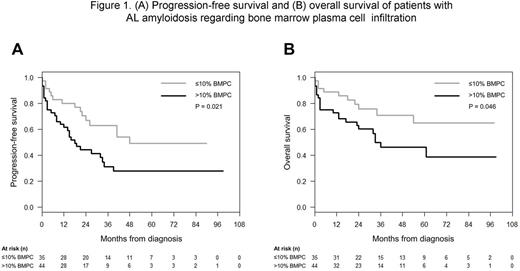Abstract
Introduction: Immunoglobulin light-chain (AL) amyloidosis is a plasma cell disorder characterized by the production of amyloidogenic immunoglobulin light chains causing organ damage. Commonly, AL amyloidosis is a low tumor burden disease, and previous reports have found that a relatively higher number of bone marrow plasma cell (BMPCs) infiltration has a dismissal prognosis.
The outcome of patients with AL amyloidosis is related to multiple factors; nevertheless, the most relevant one is the presence or not of cardiac involvement. It has long been known that the presence of multiple myeloma clinical manifestations impacts on a worse prognosis when associated to AL amyloidosis. Also the level of amyloidogenic light chain synthesis, measured by the free light chain (FLC) difference, can help to explain the heterogeneity in prognosis. In this sense, the aim of this study was to determine if the quantity of BMPCs plays a role in the outcome of the disease and the degree of organ involvement.
Methods: The clinical records of 85 patients diagnosed with systemic AL amyloidosis were reviewed at a single institution between January 2006 and April 2016. Three patients were lost to follow-up, and three were excluded because BMPC measurements were not available. Seventy-nine patients (42F/37M; median age at diagnosis 65 years) were the final study population. Complete data was collected retrospectively and baseline demographics, clinical and laboratory data, treatment received, and follow-up data were available in all patients. The risk categories were established according to the revised Mayo Clinic staging system. Twenty-five patients (31.6%) received fist-line treatment with autologous stem cell transplantation (ASCT) of which 15 patients had received pre-induction treatment and 10 patients up-front ASCT. Of the 79 patients, 44 (55.7%) received novel drugs (43% bortezomib and 12.7% lenalidomide). BMPCs were identified in bone marrow (BM) aspiration with the analysis based on optic microscopic revision of May-Grünwald-Giemsa stained bone marrow smears performed according to standard procedures. All 79 patients had BM aspirates with adequate cellularity at diagnosis and BMPC percentage was calculated. In 67 of the 79 patients, a new revision of 500 cells was performed by two independent reviewers.
Results: The median number of organs involved was two, being heart (75.9%) and kidney (64.6%) the most commonly involved. 62 patients (78.5%) had two or more involved organs. Median BMPC infiltration was 11% (IQR 7-18) with a significantly correlation to a higher serum free light chain difference (p<0.001). 18 patients (22.8%) showed more than 20% BMPC infiltration. Early mortality was higher for patients with BMPC >10% at diagnosis (27.3% vs. 11.4%; p=0.08) and the median progression-free survival (PFS) and overall survival (OS) was significantly shorter (18 months vs. 48 months; p=0.021, and 33 months vs. not reached; p=0.046; respectively) (Figure 1). Cardiac involvement was also more prevalent in patients with higher BMPC infiltration (86.4% vs. 62.9%; p=0.015). In a multivariate analysis with a model incorporating the revised Mayo risk stratification system and the percentage of BMPC infiltration, the presence of >10% BMPCs retained its independent prognostic value for worse PFS (HR=2.26; 95% CI, 1.048-4.866; p=0.038) but not in OS (HR=1.72; 95% CI, 0.695-4.261; p=0.24).
In the group of patients who did not received novel drugs, the presence of >10% of BMPC involvement resulted in a significantly shorter 3-year PFS and OS (68.7% vs. 25%; p=0.026 and 78.8% vs. 28%; p=0.013; respectively). However, those patients who received novel drugs (bortezomib and/or lenalidomide) overcome the negative prognostic impact of higher BMPC infiltration with a 3-year PFS (46.6% in ≤10% BMPC vs. 34.6% in >10% BMPC; p=0.29) and 3-year OS (62.3% in ≤10% BMPC vs. 57.3% in >10% BMPC; p=0.58). None of our patients developed CRAB criteria or any other myeloma feature during the disease evolution.
Conclusion: In patients with AL amyloidosis, a higher BMPC involvement was associated with increased cardiac involvement and a worse outcome, but this fact was never related to the presence or development of myeloma features.
Rosinol: Janssen: Honoraria; Celgene: Honoraria.
Author notes
Asterisk with author names denotes non-ASH members.


This feature is available to Subscribers Only
Sign In or Create an Account Close Modal